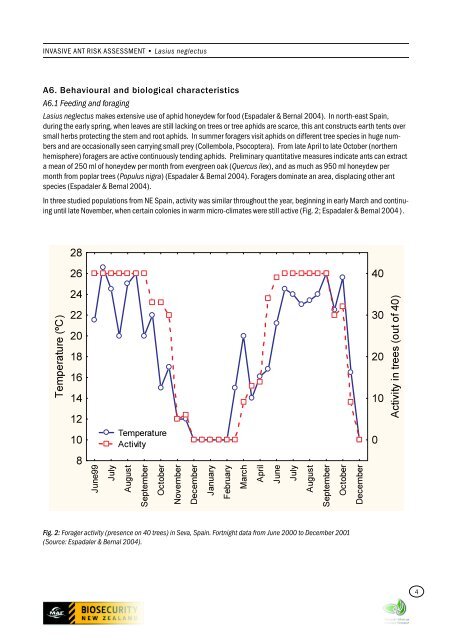Lasius neglectus (A) PEST INFORMATION - Biosecurity New Zealand
Lasius neglectus (A) PEST INFORMATION - Biosecurity New Zealand
Lasius neglectus (A) PEST INFORMATION - Biosecurity New Zealand
You also want an ePaper? Increase the reach of your titles
YUMPU automatically turns print PDFs into web optimized ePapers that Google loves.
INVASIVE ANT RISK ASSESSMENT • <strong>Lasius</strong> <strong>neglectus</strong><br />
A6. Behavioural and biological characteristics<br />
A6.1 Feeding and foraging<br />
<strong>Lasius</strong> <strong>neglectus</strong> makes extensive use of aphid honeydew for food (Espadaler & Bernal 2004). In north-east Spain,<br />
during the early spring, when leaves are still lacking on trees or tree aphids are scarce, this ant constructs earth tents over<br />
small herbs protecting the stem and root aphids. In summer foragers visit aphids on different tree species in huge numbers<br />
and are occasionally seen carrying small prey (Collembola, Psocoptera). From late April to late October (northern<br />
hemisphere) foragers are active continuously tending aphids. Preliminary quantitative measures indicate ants can extract<br />
a mean of 250 ml of honeydew per month from evergreen oak (Quercus ilex), and as much as 950 ml honeydew per<br />
month from poplar trees (Populus nigra) (Espadaler & Bernal 2004). Foragers dominate an area, displacing other ant<br />
species (Espadaler & Bernal 2004).<br />
In three studied populations from NE Spain, activity was similar throughout the year, beginning in early March and continuing<br />
until late November, when certain colonies in warm micro-climates were still active (Fig. 2; Espadaler & Bernal 2004).<br />
<br />
<br />
<br />
7HPSHUDWXUHž&<br />
<br />
<br />
<br />
<br />
<br />
<br />
<br />
<br />
<br />
<br />
$FWLYLW\LQWUHHVRXWRI<br />
<br />
7HPSHUDWXUH<br />
$FWLYLW\<br />
<br />
<br />
-XQH<br />
-XO\<br />
$XJXVW<br />
6HSWHPEHU<br />
2FWREHU<br />
1RYHPEHU<br />
'HFHPEHU<br />
-DQXDU\<br />
)HEUXDU\<br />
0DUFK<br />
$SULO<br />
-XQH<br />
-XO\<br />
$XJXVW<br />
6HSWHPEHU<br />
2FWREHU<br />
'HFHPEHU<br />
Fig. 2: Forager activity (presence on 40 trees) in Seva, Spain. Fortnight data from June 2000 to December 2001<br />
(Source: Espadaler & Bernal 2004).<br />
4
















